BMW X5 4.4I 2000 Workshop Manual
Manufacturer: BMW, Model Year: 2000, Model line: X5 4.4I, Model: BMW X5 4.4I 2000Pages: 201, PDF Size: 1.93 MB
Page 51 of 201
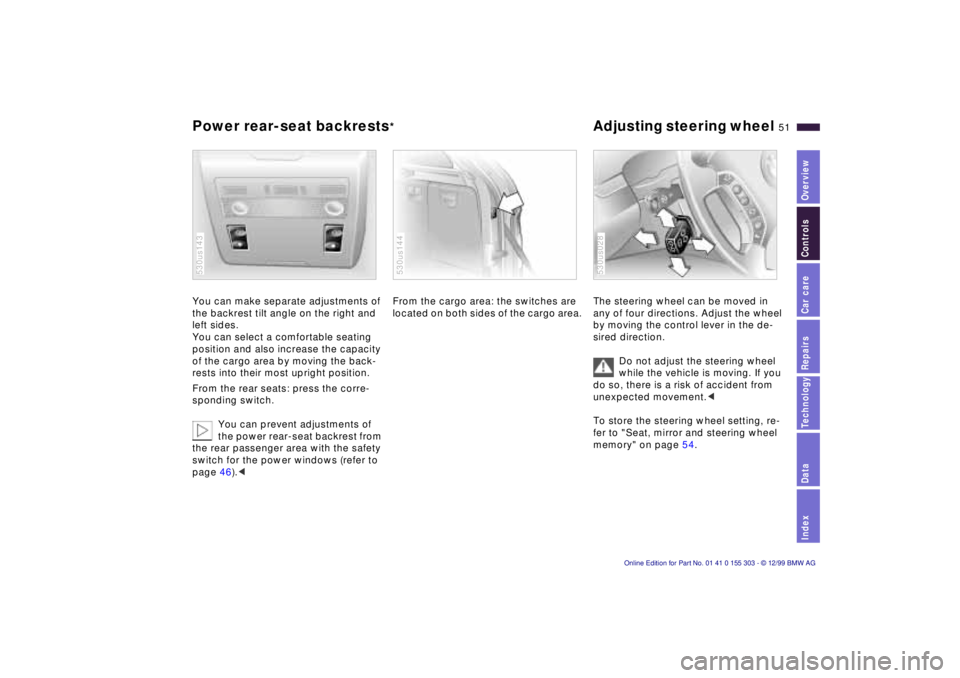
IndexDataTechnologyRepairsCar careControlsOverview
51n
Power rear-seat backrests
* Adjusting steering wheel
You can make separate adjustments of
the backrest tilt angle on the right and
left sides.
You can select a comfortable seating
position and also increase the capacity
of the cargo area by moving the back-
rests into their most upright position.
From the rear seats: press the corre-
sponding switch.
You can prevent adjustments of
the power rear-seat backrest from
the rear passenger area with the safety
switch for the power windows (refer to
page 46).<530us143
From the cargo area: the switches are
located on both sides of the cargo area. 530us144
The steering wheel can be moved in
any of four directions. Adjust the wheel
by moving the control lever in the de-
sired direction.
Do not adjust the steering wheel
while the vehicle is moving. If you
do so, there is a risk of accident from
unexpected movement.<
To store the steering wheel setting, re-
fer to "Seat, mirror and steering wheel
memory" on page 54. 530us028
Page 52 of 201
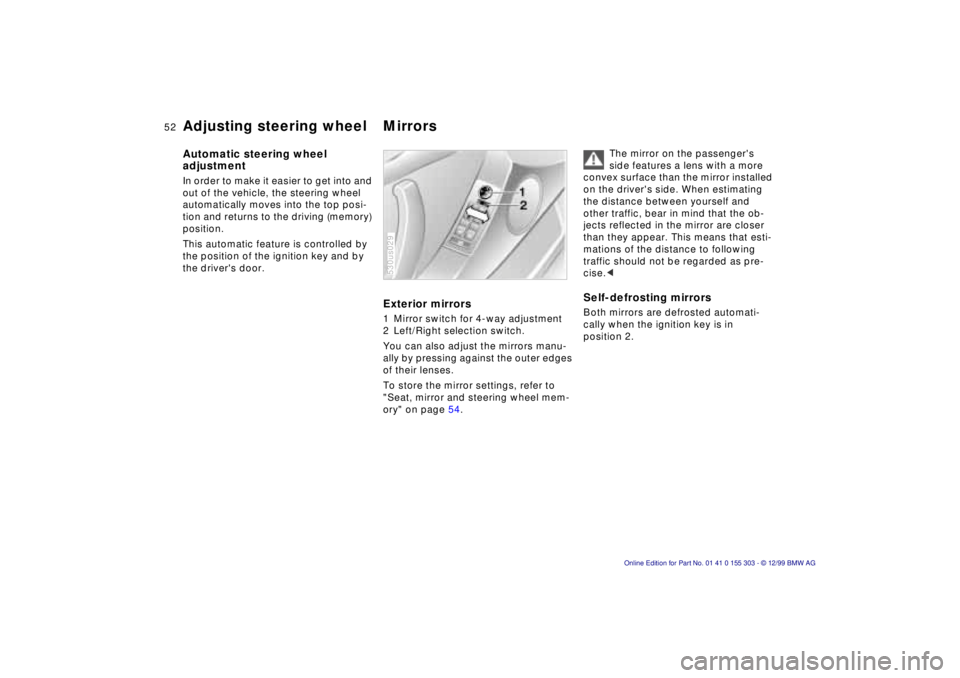
52n
Adjusting steering wheel Mirrors Automatic steering wheel
adjustment In order to make it easier to get into and
out of the vehicle, the steering wheel
automatically moves into the top posi-
tion and returns to the driving (memory)
position.
This automatic feature is controlled by
the position of the ignition key and by
the driver's door.
Exterior mirrors 1 Mirror switch for 4-way adjustment
2 Left/Right selection switch.
You can also adjust the mirrors manu-
ally by pressing against the outer edges
of their lenses.
To store the mirror settings, refer to
"Seat, mirror and steering wheel mem-
ory" on page 54. 530us029
The mirror on the passenger's
side features a lens with a more
convex surface than the mirror installed
on the driver's side. When estimating
the distance between yourself and
other traffic, bear in mind that the ob-
jects reflected in the mirror are closer
than they appear. This means that esti-
mations of the distance to following
traffic should not be regarded as pre-
cise.<
Self-defrosting mirrors Both mirrors are defrosted automati-
cally when the ignition key is in
position 2.
Page 53 of 201
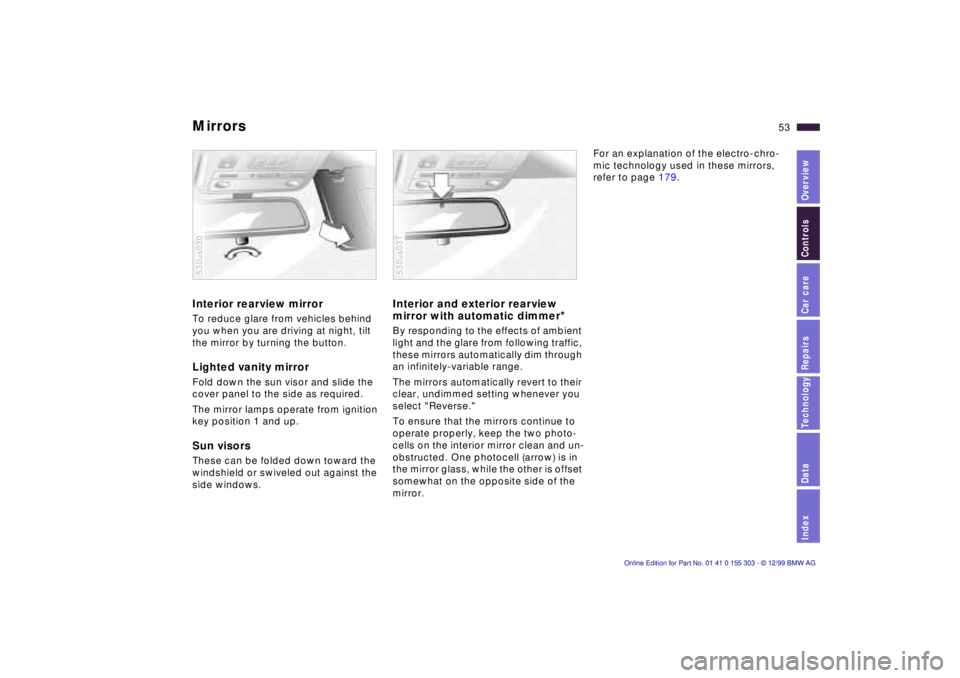
IndexDataTechnologyRepairsCar careControlsOverview
53n
Mirrors Interior rearview mirror To reduce glare from vehicles behind
you when you are driving at night, tilt
the mirror by turning the button. Lighted vanity mirror Fold down the sun visor and slide the
cover panel to the side as required.
The mirror lamps operate from ignition
key position 1 and up. Sun visors These can be folded down toward the
windshield or swiveled out against the
side windows. 530us030
Interior and exterior rearview
mirror with automatic dimmer
*
By responding to the effects of ambient
light and the glare from following traffic,
these mirrors automatically dim through
an infinitely-variable range.
The mirrors automatically revert to their
clear, undimmed setting whenever you
select "Reverse."
To ensure that the mirrors continue to
operate properly, keep the two photo-
cells on the interior mirror clean and un-
obstructed. One photocell (arrow) is in
the mirror glass, while the other is offset
somewhat on the opposite side of the
mirror. 530us031
For an explanation of the electro-chro-
mic technology used in these mirrors,
refer to page 179.
Page 54 of 201
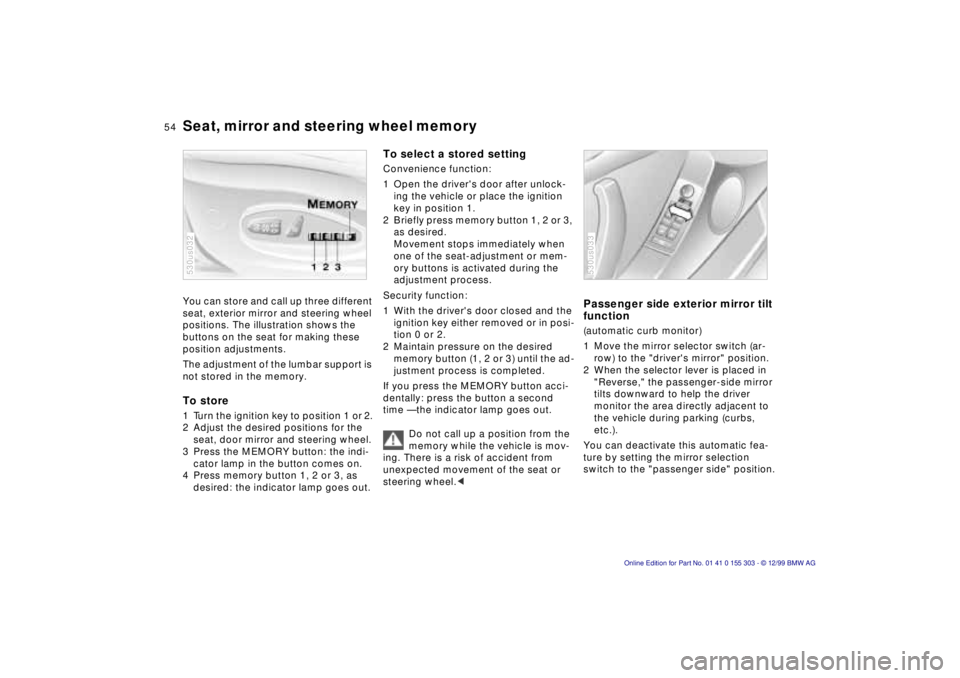
54n
Seat, mirror and steering wheel memory You can store and call up three different
seat, exterior mirror and steering wheel
positions. The illustration shows the
buttons on the seat for making these
position adjustments.
The adjustment of the lumbar support is
not stored in the memory. To store 1 Turn the ignition key to position 1 or 2.
2 Adjust the desired positions for the
seat, door mirror and steering wheel.
3 Press the MEMORY button: the indi-
cator lamp in the button comes on.
4 Press memory button 1, 2 or 3, as
desired: the indicator lamp goes out. 530us032
To select a stored settingConvenience function:
1 Open the driver's door after unlock-
ing the vehicle or place the ignition
key in position 1.
2 Briefly press memory button 1, 2 or 3,
as desired.
Movement stops immediately when
one of the seat-adjustment or mem-
ory buttons is activated during the
adjustment process.
Security function:
1 With the driver's door closed and the
ignition key either removed or in posi-
tion 0 or 2.
2 Maintain pressure on the desired
memory button (1, 2 or 3) until the ad-
justment process is completed.
If you press the MEMORY button acci-
dentally: press the button a second
time Ñ the indicator lamp goes out.
Do not call up a position from the
memory while the vehicle is mov-
ing. There is a risk of accident from
unexpected movement of the seat or
steering wheel.<
Passenger side exterior mirror tilt
function(automatic curb monitor)
1 Move the mirror selector switch (ar-
row) to the "driver's mirror" position.
2 When the selector lever is placed in
"Reverse," the passenger-side mirror
tilts downward to help the driver
monitor the area directly adjacent to
the vehicle during parking (curbs,
etc.).
You can deactivate this automatic fea-
ture by setting the mirror selection
switch to the "passenger side" position.530us033
Page 55 of 201
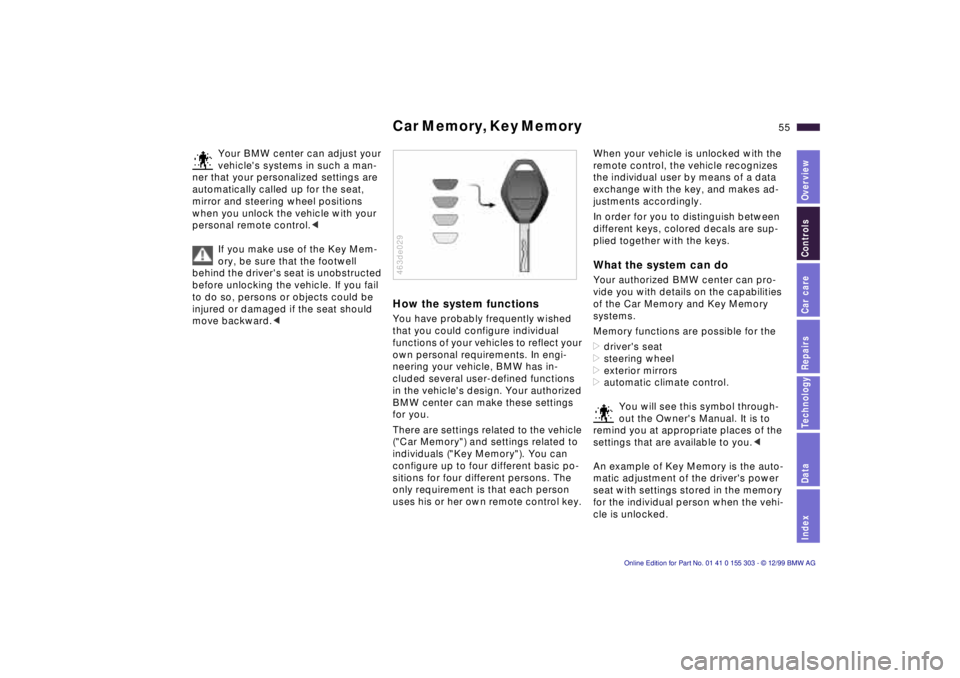
IndexDataTechnologyRepairsCar careControlsOverview
55n
Car Memory, Key Memory
Your BMW center can adjust your
vehicle's systems in such a man-
ner that your personalized settings are
automatically called up for the seat,
mirror and steering wheel positions
when you unlock the vehicle with your
personal remote control.<
If you make use of the Key Mem-
ory, be sure that the footwell
behind the driver's seat is unobstructed
before unlocking the vehicle. If you fail
to do so, persons or objects could be
injured or damaged if the seat should
move backward.<
How the system functions You have probably frequently wished
that you could configure individual
functions of your vehicles to reflect your
own personal requirements. In engi-
neering your vehicle, BMW has in-
cluded several user-defined functions
in the vehicle's design. Your authorized
BMW center can make these settings
for you.
There are settings related to the vehicle
("Car Memory") and settings related to
individuals ("Key Memory"). You can
configure up to four different basic po-
sitions for four different persons. The
only requirement is that each person
uses his or her own remote control key. 463de029
When your vehicle is unlocked with the
remote control, the vehicle recognizes
the individual user by means of a data
exchange with the key, and makes ad-
justments accordingly.
In order for you to distinguish between
different keys, colored decals are sup-
plied together with the keys. What the system can do Your authorized BMW center can pro-
vide you with details on the capabilities
of the Car Memory and Key Memory
systems.
Memory functions are possible for the
>driver's seat
>steering wheel
>exterior mirrors
>automatic climate control.
You will see this symbol through-
out the Owner's Manual. It is to
remind you at appropriate places of the
settings that are available to you.<
An example of Key Memory is the auto-
matic adjustment of the driver's power
seat with settings stored in the memory
for the individual person when the vehi-
cle is unlocked.
Page 56 of 201
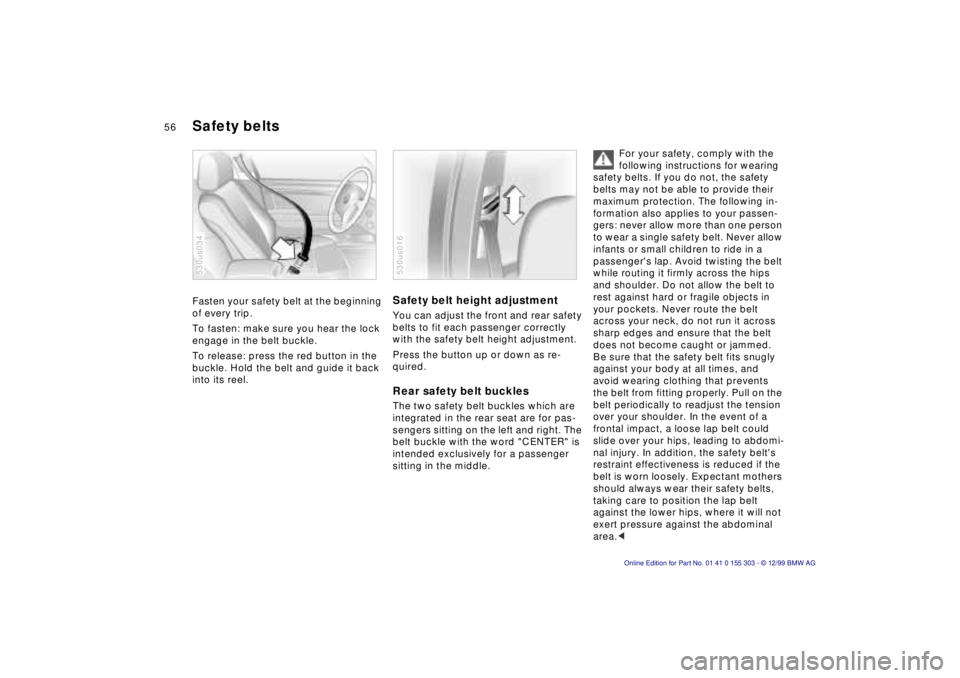
56n
Fasten your safety belt at the beginning
of every trip.
To fasten: make sure you hear the lock
engage in the belt buckle.
To release: press the red button in the
buckle. Hold the belt and guide it back
into its reel.
530us034
Safety belt height adjustment You can adjust the front and rear safety
belts to fit each passenger correctly
with the safety belt height adjustment.
Press the button up or down as re-
quired. Rear safety belt buckles The two safety belt buckles which are
integrated in the rear seat are for pas-
sengers sitting on the left and right. The
belt buckle with the word "CENTER" is
intended exclusively for a passenger
sitting in the middle.530us016
For your safety, comply with the
following instructions for wearing
safety belts. If you do not, the safety
belts may not be able to provide their
maximum protection. The following in-
formation also applies to your passen-
gers: never allow more than one person
to wear a single safety belt. Never allow
infants or small children to ride in a
passenger's lap. Avoid twisting the belt
while routing it firmly across the hips
and shoulder. Do not allow the belt to
rest against hard or fragile objects in
your pockets. Never route the belt
across your neck, do not run it across
sharp edges and ensure that the belt
does not become caught or jammed.
Be sure that the safety belt fits snugly
against your body at all times, and
avoid wearing clothing that prevents
the belt from fitting properly. Pull on the
belt periodically to readjust the tension
over your shoulder. In the event of a
frontal impact, a loose lap belt could
slide over your hips, leading to abdomi-
nal injury. In addition, the safety belt's
restraint effectiveness is reduced if the
belt is worn loosely. Expectant mothers
should always wear their safety belts,
taking care to position the lap belt
against the lower hips, where it will not
exert pressure against the abdominal
area.<
Safety belts
Page 57 of 201
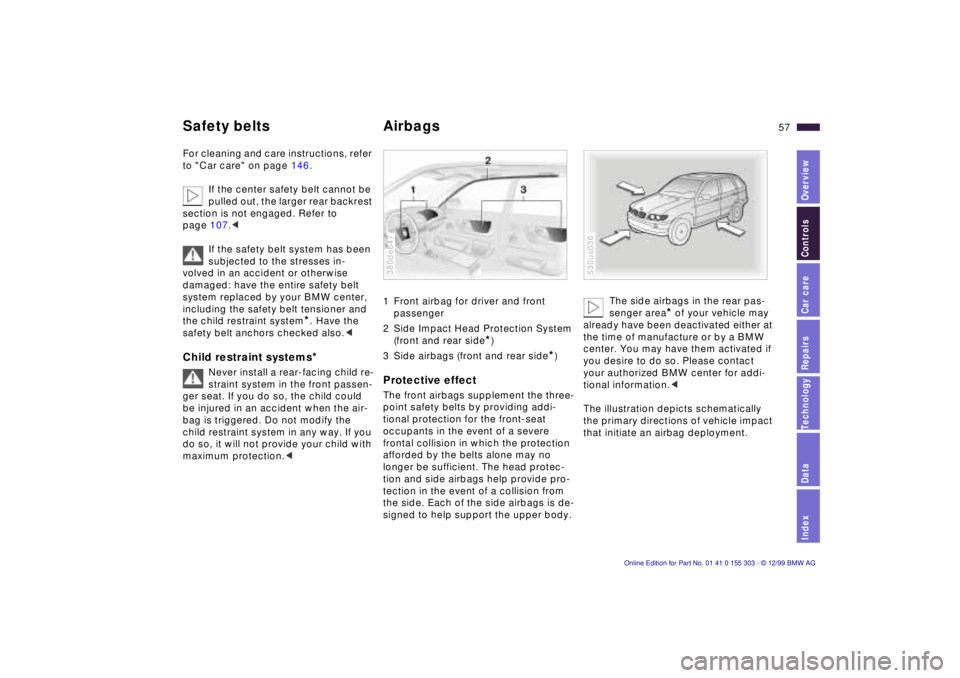
IndexDataTechnologyRepairsCar careControlsOverview
57n
Safety belts Airbags For cleaning and care instructions, refer
to "Car care" on page 146.
If the center safety belt cannot be
pulled out, the larger rear backrest
section is not engaged. Refer to
page 107.<
If the safety belt system has been
subjected to the stresses in-
volved in an accident or otherwise
damaged: have the entire safety belt
system replaced by your BMW center,
including the safety belt tensioner and
the child restraint system
*. Have the
safety belt anchors checked also.c
Child restraint systems
*
Never install a rear-facing child re-
straint system in the front passen-
ger seat. If you do so, the child could
be injured in an accident when the air-
bag is triggered. Do not modify the
child restraint system in any way. If you
do so, it will not provide your child with
maximum protection.<
1 Front airbag for driver and front
passenger
2 Side Impact Head Protection System
(front and rear side
*)
3 Side airbags (front and rear side
*)
Protective effect The front airbags supplement the three-
point safety belts by providing addi-
tional protection for the front-seat
occupants in the event of a severe
frontal collision in which the protection
afforded by the belts alone may no
longer be sufficient. The head protec-
tion and side airbags help provide pro-
tection in the event of a collision from
the side. Each of the side airbags is de-
signed to help support the upper body. 380de647
The side airbags in the rear pas-
senger area
* of your vehicle may
already have been deactivated either at
the time of manufacture or by a BMW
center. You may have them activated if
you desire to do so. Please contact
your authorized BMW center for addi-
tional information.<
The illustration depicts schematically
the primary directions of vehicle impact
that initiate an airbag deployment.
530us036
Page 58 of 201
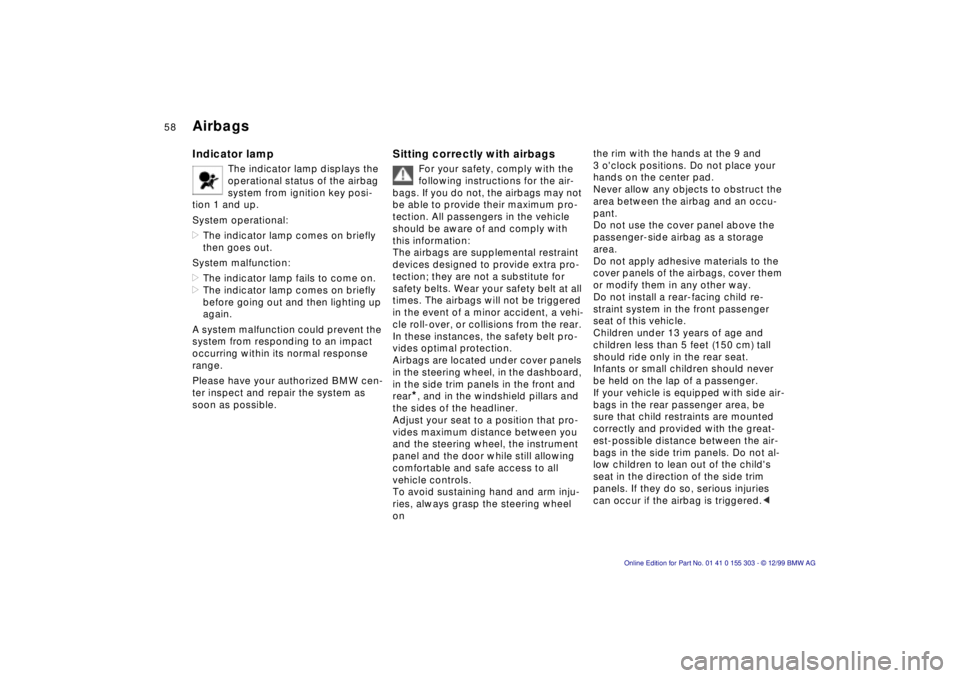
58n
Airbags Indicator lamp
The indicator lamp displays the
operational status of the airbag
system from ignition key posi-
tion 1 and up.
System operational:
>The indicator lamp comes on briefly
then goes out.
System malfunction:
>The indicator lamp fails to come on.
>The indicator lamp comes on briefly
before going out and then lighting up
again.
A system malfunction could prevent the
system from responding to an impact
occurring within its normal response
range.
Please have your authorized BMW cen-
ter inspect and repair the system as
soon as possible.
Sitting correctly with airbags
For your safety, comply with the
following instructions for the air-
bags. If you do not, the airbags may not
be able to provide their maximum pro-
tection. All passengers in the vehicle
should be aware of and comply with
this information:
The airbags are supplemental restraint
devices designed to provide extra pro-
tection; they are not a substitute for
safety belts. Wear your safety belt at all
times. The airbags will not be triggered
in the event of a minor accident, a vehi-
cle roll-over, or collisions from the rear.
In these instances, the safety belt pro-
vides optimal protection.
Airbags are located under cover panels
in the steering wheel, in the dashboard,
in the side trim panels in the front and
rear*, and in the windshield pillars and
the sides of the headliner.
Adjust your seat to a position that pro-
vides maximum distance between you
and the steering wheel, the instrument
panel and the door while still allowing
comfortable and safe access to all
vehicle controls.
To avoid sustaining hand and arm inju-
ries, always grasp the steering wheel
on
the rim with the hands at the 9 and
3 o'clock positions. Do not place your
hands on the center pad.
Never allow any objects to obstruct the
area between the airbag and an occu-
pant.
Do not use the cover panel above the
passenger-side airbag as a storage
area.
Do not apply adhesive materials to the
cover panels of the airbags, cover them
or modify them in any other way.
Do not install a rear-facing child re-
straint system in the front passenger
seat of this vehicle.
Children under 13 years of age and
children less than 5 feet (150 cm) tall
should ride only in the rear seat.
Infants or small children should never
be held on the lap of a passenger.
If your vehicle is equipped with side air-
bags in the rear passenger area, be
sure that child restraints are mounted
correctly and provided with the great-
est-possible distance between the air-
bags in the side trim panels. Do not al-
low children to lean out of the child's
seat in the direction of the side trim
panels. If they do so, serious injuries
can occur if the airbag is triggered.<
Page 59 of 201
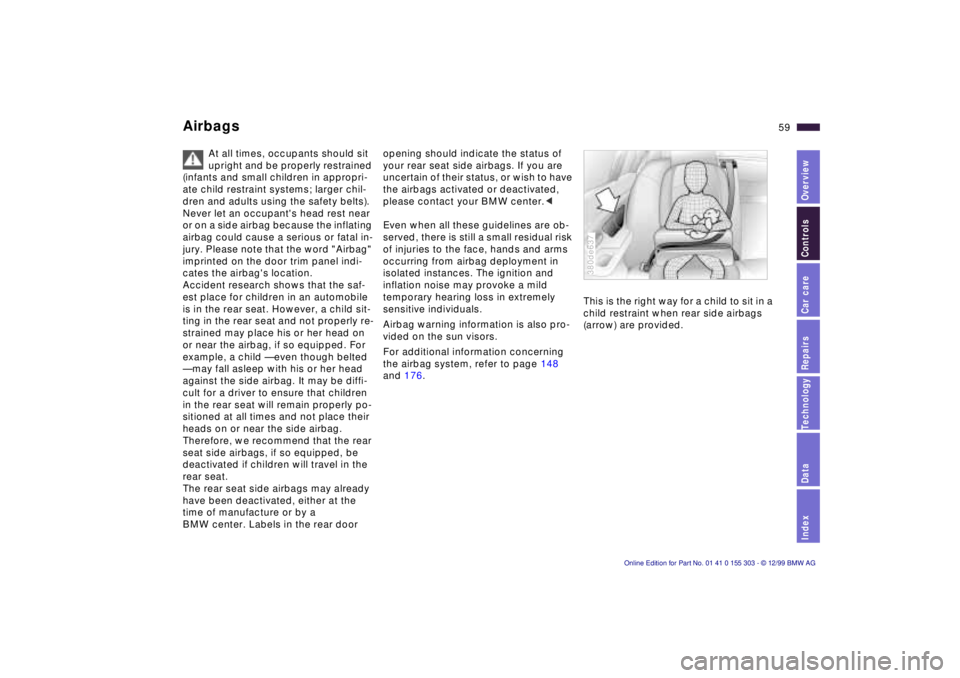
IndexDataTechnologyRepairsCar careControlsOverview
59n
Airbags
At all times, occupants should sit
upright and be properly restrained
(infants and small children in appropri-
ate child restraint systems; larger chil-
dren and adults using the safety belts).
Never let an occupant's head rest near
or on a side airbag because the inflating
airbag could cause a serious or fatal in-
jury. Please note that the word "Airbag"
imprinted on the door trim panel indi-
cates the airbag's location.
Accident research shows that the saf-
est place for children in an automobile
is in the rear seat. However, a child sit-
ting in the rear seat and not properly re-
strained may place his or her head on
or near the airbag, if so equipped. For
example, a child Ñ even though belted
Ñ may fall asleep with his or her head
against the side airbag. It may be diffi-
cult for a driver to ensure that children
in the rear seat will remain properly po-
sitioned at all times and not place their
heads on or near the side airbag.
Therefore, we recommend that the rear
seat side airbags, if so equipped, be
deactivated if children will travel in the
rear seat.
The rear seat side airbags may already
have been deactivated, either at the
time of manufacture or by a
BMW center. Labels in the rear door
opening should indicate the status of
your rear seat side airbags. If you are
uncertain of their status, or wish to have
the airbags activated or deactivated,
please contact your BMW center.<
Even when all these guidelines are ob-
served, there is still a small residual risk
of injuries to the face, hands and arms
occurring from airbag deployment in
isolated instances. The ignition and
inflation noise may provoke a mild
temporary hearing loss in extremely
sensitive individuals.
Airbag warning information is also pro-
vided on the sun visors.
For additional information concerning
the airbag system, refer to page 148
and 176. This is the right way for a child to sit in a
child restraint when rear side airbags
(arrow) are provided.
380de637
Page 60 of 201
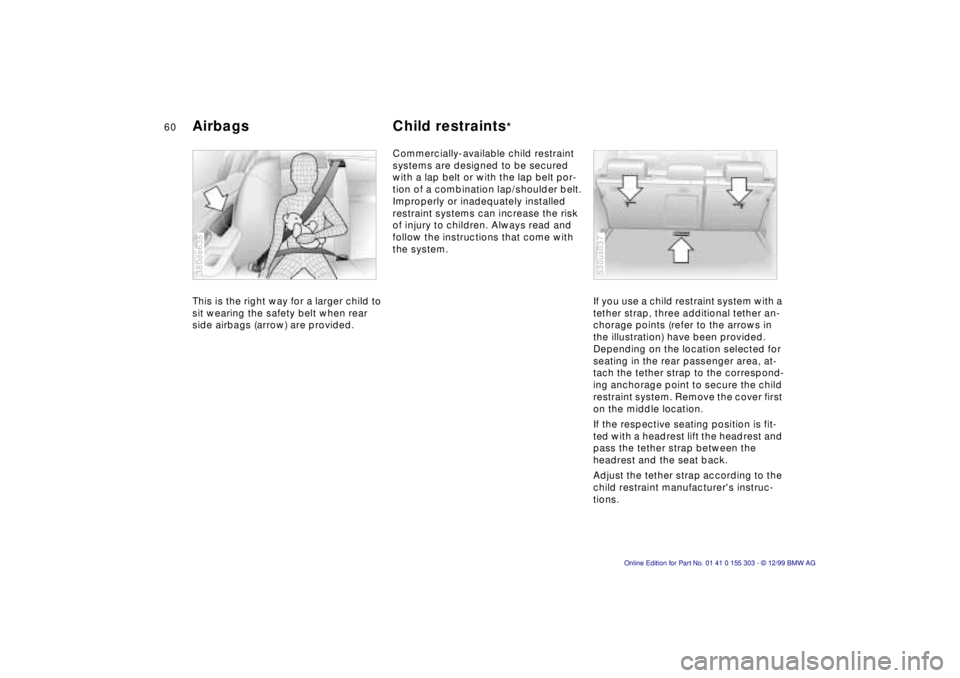
60n
Airbags Child restraints
*
This is the right way for a larger child to
sit wearing the safety belt when rear
side airbags (arrow) are provided. 380de638
Commercially-available child restraint
systems are designed to be secured
with a lap belt or with the lap belt por-
tion of a combination lap/shoulder belt.
Improperly or inadequately installed
restraint systems can increase the risk
of injury to children. Always read and
follow the instructions that come with
the system.
If you use a child restraint system with a
tether strap, three additional tether an-
chorage points (refer to the arrows in
the illustration) have been provided.
Depending on the location selected for
seating in the rear passenger area, at-
tach the tether strap to the correspond-
ing anchorage point to secure the child
restraint system. Remove the cover first
on the middle location.
If the respective seating position is fit-
ted with a headrest lift the headrest and
pass the tether strap between the
headrest and the seat back.
Adjust the tether strap according to the
child restraint manufacturer's instruc-
tions.
530us037